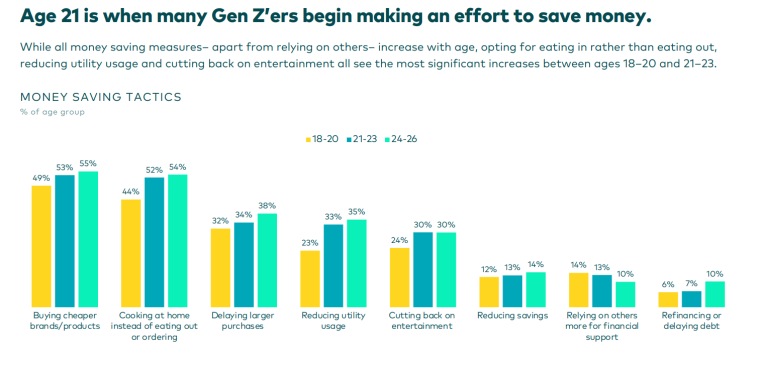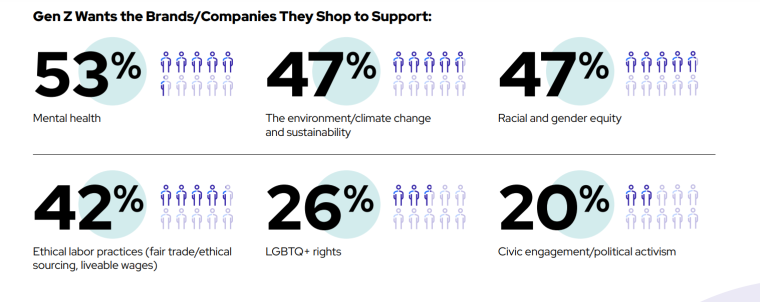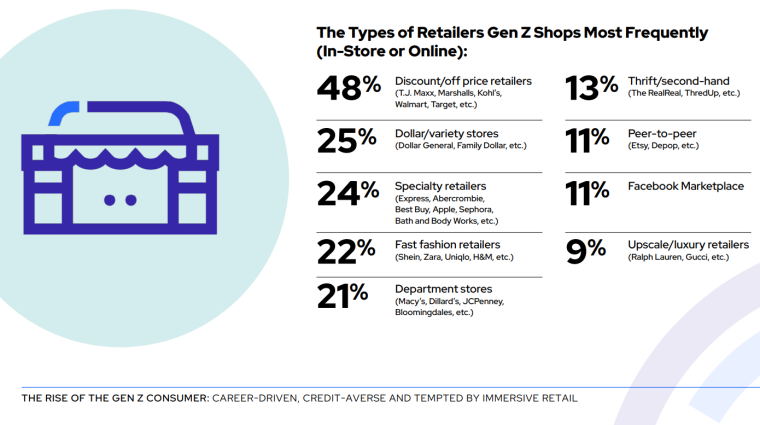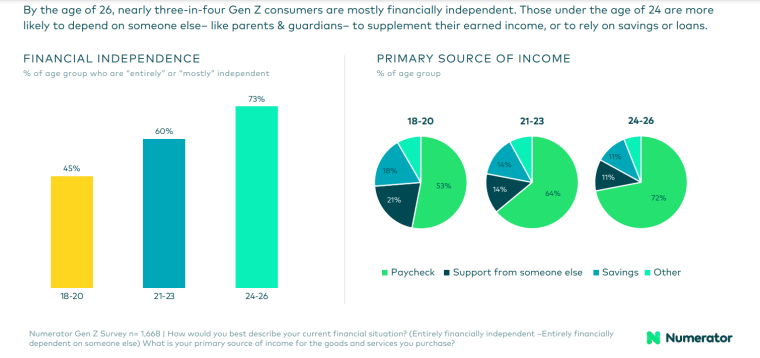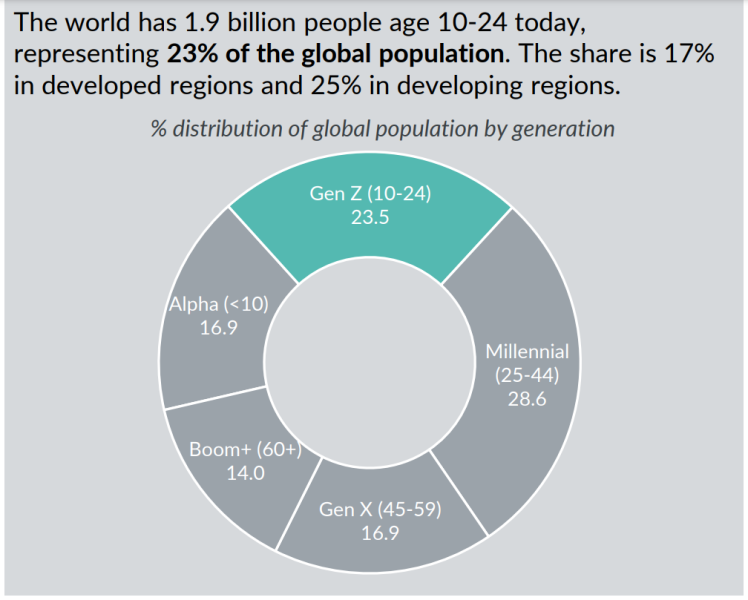Gen Z teenagers are those born between 1997 and 2012, which make up one in four of the world’s population. and is set to become the largest consumer group this decade. To reach this important new generation group Businesses and marketers must take a deeper look at Gen Z trends and their needs.
Deciphering Gen Z behaviors can be challenging. which is the reason that Why did we compile this guide to 2025‘s most influential Gen Z trends? Discover all the latest information about this generation, including their values, purchasing power, spending habits, and more.
Summary of Gen Z trends
- Gen Z makes up 27% of the U.S. population and 25% of the world’s population.
- Gen Z purchasing power is expected to exceed $33 trillion over the next decade.
- Gen Z trends like retro trends Remains popular throughout the year 2025
- Core values like sustainability and affordability shape Gen Z consumer behavior.
- Working from anywhere and variety of work It is the most important thing for Gen Z employees.
Gen Z trends in purchasing
According to a GFK report 2025 , Gen Z has the fastest growing purchasing power of any generation globally. Their income is set to grow 400% over the next ten years, reaching more than $33 trillion. This age group will account for more than 25% of global income by 2030 and will overtake Gen Y’s purchasing power in 2031.
model
Year of birth
Average cost per year
Silent Generation
1928-1945
$44,683
Baby Boomers
1946-1964
$62,203
Generation X
1965-1980
$83,357
Gen Y
1981-1996
$69,061
Generation Z
1997-2012
$41,636
Research by Numerator reveals that Gen Z ages 18 to 26 will change their spending accordingly. (eating out and clothing) to essential spending And grocery will become a popular category for Gen Z shoppers, replacing eating out.
Spending in categories such as entertainment, housing, and apparel However, not all categories experience linear growth. Grocery store spending It decreases when they’re about 21-23 years old, which is when many Gen Z people start to be more budget-conscious.
Jungle Scout’s 2025 research finds that Gen Z trends are setting new standards in ecommerce:
- 43% of Gen Z people search for products online on TikTok , which is more than they search on Google.
- Despite rising inflation, 32% of Gen Zers shop online at least once a day, compared to 25% of Gen Y, 15% of Gen X and 7% of Baby Boomers.
- Compared to other generations, Gen Zers are more likely to shop secondhand online to save money, with 42% purchasing secondhand goods online in the past year.
Value-Driven Purchasing Decisions
According to McKinsey, Gen Z values sustainability. Taking into account the environment and society
This generation chooses brands with a clear mission or purpose, with 73% saying they would buy from ethical companies and 90% interested in companies that take responsibility for solving environmental and social issues.
This is consistent with an ICSC report from 2025 that shows Gen Z is a socially and environmentally conscious generation. and want to support brands that align with their values
Mental health is a top value in Gen Z lifestyles, with 53% saying they want to support brands that address this issue.
The subject of interest to teenagers 2025 must be able to solve the following problems, such as:
- environment
- Greenhouse gas conditions
- Sustainability
- Racial and gender equality
Social Media Driven Purchases
Gen Z trends trust influencers, family, and friends to influence purchasing decisions. In the US, 40% of Gen Z people make purchasing decisions after watching a video.
According to a GWI report, 30% of Gen Z consider user-generated content on social media to be an important source of purchasing decisions. and are 11% more likely to do this than other generations.
แพลตฟอร์มโซเชียลได้กลายเป็นพื้นที่หลักในการค้นหาแบรนด์ และคน Gen Z หันมาใช้โซเชียลด้วยเหตุผลนี้เพิ่มขึ้นถึง 35% ตั้งแต่ปี 2015 เนื่องจากให้ความสำคัญกับคำแนะนำ และแนวคิดจากเรื่องจริง ก่อนตัดสินใจซื้อ

ส่วนแพลตฟอร์ม Social Media อื่น ๆ ก็มีอิทธิพลต่อการตัดสินใจซื้อเช่นกัน ดังนี้:
- YouTube (38%)
- Facebook (24%)
- Snapchat (17%)
- Twitter (14%)
- Reddit (7%)
การซื้อโดยคำนึงถึงต้นทุน
แม้ว่าเทรนด์ Gen Z จะใส่ใจเรื่องต้นทุนและชอบส่วนลด แต่พวกเขายินดีที่จ่ายมากขึ้นเพื่อประสบการณ์ที่ตรงกับความคาดหวัง เกือบครึ่งหนึ่งของผู้ตอบแบบสอบถามในแบบสำรวจของ ICSC กล่าวว่า พวกเขายินดีจ่ายเบี้ยประกันภัย เพื่อให้คำสั่งซื้อออนไลน์ได้รับการจัดส่งที่เร็วขึ้น
รายงานเดียวกันนี้พบว่า แบรนด์ที่มีส่วนลด เช่น TJ Maxx, Marshalls, Kohl’s, Walmart และ Target จะกลายเป็นแหล่งช้อปปิ้งที่ต้องการของผู้ตอบแบบสำรวจ 48% ของ ส่วนแหล่งช็อปปิ้งอื่น ๆ ได้แก่:
- Dollar และร้านค้าอื่น ๆ เช่น Dollar General และ Family Dollar – 25%
- แบรนด์เฉพาะทาง เช่น Urban Outfitters, Abercrombie & Fitch, Best Buy และ Sephora – 24%
- แบรนด์ Fast-fashion เช่น Shein หรือ Zara – 22%
- ห้างสรรพสินค้า – 21%
- ร้านขายของมือสอง – 13%
การเข้าถึงและความสะดวกสบาย
ลำดับความสำคัญในการจับจ่ายสำหรับเทรนด์ Gen Z ได้แก่ ความสะดวก ประสิทธิภาพ และความรวดเร็ว โดยการสำรวจของ ICSC พบว่า:
- 46% ของคน Gen Z ให้คะแนน การชำระเงินที่ง่ายและรวดเร็ว เป็นปัจจัยที่สำคัญที่สุดในการช็อปปิ้ง
- การจัดส่งที่รวดเร็ว (45%) และ การได้สิ่งที่ต้องการในทันที (39%)
- การคืนสินค้าฟรี (31%) และการบริการลูกค้าที่รวดเร็ว/เป็นประโยชน์ (27%)
- ความสามารถในการตรวจสอบความพร้อมของสินค้าล่วงหน้า (23%) และตัวเลือกการซื้อทางออนไลน์และหน้าร้าน (23%)
เทรนด์ Gen Z ยังให้ความสำคัญกับการเข้าถึงมากกว่าการเป็นเจ้าของ กล่าวคือ แทนที่จะซื้อภาพยนตร์หรือเพลง พวกเขาจะเลือกสมัครรับข้อมูลจากแพลตฟอร์มสตรีมมิ่งมากกว่าคนรุ่นอื่น ๆ และยังนิยมใช้บริการต่าง ๆ เช่น การเช่ารถยนต์ และการเช่าเสื้อผ้าอีกด้วย
แบรนด์สำหรับ Gen Z
เทคโนโลยี
จากข้อมูลของ Salesforce พบว่า 70% ของกลุ่ม Gen Z มีรายงานการใช้ Generative AI และ 52% ใช้เทคโนโลยีนี้เพื่อช่วยในการตัดสินใจ
สิ่งที่วัยรุ่นสนใจในปัจจุบัน คือ Metaverse ซึ่งมากกว่าครึ่งใช้เพื่อเล่นเกมหรือดูทีวี/ภาพยนตร์ ส่วนที่เหลือใช้เพื่อสร้างปฏิสัมพันธ์กับเพื่อน/ครอบครัว หรือผู้คนใหม่ ๆ
ด้วยความคิดถึงอดีต ความกังวลเกี่ยวกับความเป็นส่วนตัว และความจำเป็นในการ “Digitally Detox” โทรศัพท์ฝาพับจึงกลับมาติดเทรนด์ Gen Z อีกครั้ง ตามรายงานของ CNBC ยอดขายโทรศัพท์ฝาพับกำลังเพิ่มสูงขึ้นในสหรัฐอเมริกา ทั้ง Samsung, Nokia และ Motorola ก็ต่างออกสินค้าเป็นโทรศัพท์ฝาพับสุดคลาสสิกรุ่นใหม่ เพื่อเอาใจคนรุ่นนี้
Razr Flip โทรศัพท์รุ่นใหม่ของ Motorola
กลุ่ม Gen Z เลือกที่จะเป็นเจ้าของทั้งสมาร์ทโฟนและโทรศัพท์ฝาพับ ซึ่งช่วยให้พวกเขาลดเวลาการอยู่หน้าจอ และเวลาในชีวิตประจำวันได้มากขึ้น
เพื่อหลีกเลี่ยงการออนไลน์อยู่ตลอดเวลา พวกเขาจึงกลับไปใช้อุปกรณ์แบบใช้ครั้งเดียว หรือเทคโนโลยีย้อนยุค เช่น กล้องถ่ายวิดีโอ กล้องถ่ายรูปแบบใช้แล้วทิ้ง และ Walkman อีกครั้ง
แฟชั่น
กลุ่ม Gen Z ส่วนใหญ่ ให้ความสำคัญกับเสื้อผ้าที่มีเอกลักษณ์และแสดงออกถึงอารมณ์ พวกเขามีรสนิยมที่เปลี่ยนแปลงอย่างรวดเร็ว ซึ่งได้รับแรงบันดาลใจจากเทรนวัยรุ่น 2025 ล่าสุด นั่นเป็นเหตุผลว่าทำไมแบรนด์ต่าง ๆ เช่น Shein ซึ่งเป็นยักษ์ใหญ่ด้าน fast-fashion จึงออกผลิตภัณฑ์ใหม่ ๆ บนเว็บไซต์มากถึง 6,000 รายการทุกวัน และกลายเป็นบริษัทที่ติดเทรนด์ Gen Z
เนื่องจาก 54% ของคน Gen Z ชอบสไตล์เสื้อผ้าวินเทจ และนำเทรนด์แฟชั่นในยุค 90 และต้นยุค 2000 กลับมาอีกครั้ง และคาดว่าจะดำเนินต่อไปในปี 2025
แฟชั่นหมุนเวียนเช่นนี้ ทำให้กลุ่ม Gen Z สนุกและประหยัดได้ด้วย ส่วนการขายต่อก็เติบโตอย่างเห็นได้ชัด เนื่องจากแบรนด์และ Influencer จึงเป็นเรื่องปกติที่ตู้เสื้อผ้าของคน Gen Z จะประกอบไปด้วยเสื้อผ้าแนว Fast fashion และเสื้อผ้าวินเทจ
ความบันเทิง
แบรนด์ต่าง ๆ เช่น Netflix, Disney Plus และ Spotify ยังเป็นส่วนหนึ่งของเทรนด์ Gen Z ต่อไป และเมื่อพูดถึงบริการสตรีมมิ่ง เนื้อหาคือสิ่งสำคัญที่คนรุ่นนี้คาดหวัง:
- เนื้อหาเกี่ยวกับสิ่งที่พวกเขาสนใจ
- เนื้อหาที่หลากหลาย
- เนื้อหาที่อัปเดตเป็นประจำ
55% ของวัยรุ่นเจนZ สนับสนุนโฆษณาในบริการสตรีมมิ่งเพื่อช่วยลดต้นทุน ในปี 2022 แบรนด์อย่าง Netflix และ Disney Plus ร่วมมือกับ HBO Max และ Hulu เพื่อเสนอโฆษณาที่ถูกลง
จากข้อมูลของ GWI พบว่า Gen Z ฟังเพลงเพื่อปิดกั้นการรับรู้ (42%) และเพื่อความบันเทิง (54%) เนื่องจากการกำหนดแนวเพลงเป็นเรื่องที่ยากขึ้น แบรนด์ดังอย่าง Spotify จึงประสบความสำเร็จอย่างมาก ในการสร้างเพลย์ลิสต์ให้ตรงกับอารมณ์ที่แตกต่างกัน
Social Media
เนื่องจากเทรนด์ Gen Z ใช้งานอุปกรณ์ดิจิทัลเป็นหลัก จึงสามารถเข้าถึงอินเทอร์เน็ตและอุปกรณ์เคลื่อนที่ได้แบบไม่จำกัดตั้งแต่อายุยังน้อย นี่จึงไม่ใช่เรื่องน่าแปลกใจที่ Gen Z จะใช้เวลาเล่นโซเชียลมากกว่า 6 ชั่วโมงต่อวัน เพื่อวัตถุประสงค์ ได้แก่:
- ซื้อสินค้า
- เข้าถึงเนื้อหาที่สนุกสนาน
- ค้นหาแบรนด์ใหม่
- เล่นเกม
- เข้าถึงวัฒนธรรมป๊อป
- หางานหรือสิ่งที่สนใจ
- ติดต่อเพื่อน ๆ และครอบครัว
TikTok, Snapchat, Tumblr และ Reddit ได้รับความนิยมในหมู่ Gen Z มากกว่าคนรุ่นอื่น ๆ ถึง 2-3 เท่า โดยเฉพาะอย่างยิ่ง TikTok ที่ได้รับความนิยมเพิ่มขึ้นอย่างรวดเร็ว เมื่อ Gen Z เติบโตขึ้น TikTok ยังคงเป็นจุดหมายปลายทางหลักสำหรับคนกลุ่มนี้ ซึ่งคิดเป็นกว่า 60% ของผู้ใช้ TikTok
เทรนด์ Gen Z ต่างจากคนรุ่นก่อน ๆ ในเรื่องการดูแลสุขภาพจิตและการสร้างตัวตนบนโลกออนไลน์ ข้อมูลจาก GWI แสดงให้เห็นว่า การใช้ Social media ของ Gen Z ลดลงจากปัญหาสุขภาพจิต อย่างไรก็ตาม การใช้ Social media สำหรับคนรุ่นอื่น ๆ ก็สูงมากขึ้นเรื่อย ๆ เช่นกัน
นอกจากนี้:
- 1 ใน 3 ของคน Gen Z กังวลว่า พวกเขาใช้เวลากับ Social media มากเกินไป
- 20% บอกว่า Social media ทำให้พวกเขาวิตกกังวล ซึ่งมากกว่าคนรุ่นอื่น ๆ ถึง 25%
- คน Gen Z กล่าวว่าโซเชียลมีเดียส่งผลเสียต่ออาการ FOMO (หญิง32%, ชาย 22%) ภาพลักษณ์ (หญิง32%, ชาย 16%) และความมั่นใจในตนเอง (หญิง 24%, ชาย 13%)
การท่องเที่ยว
เนื่องจากเทรนด์ Gen Z เปลี่ยนแปลงอยู่ตลอดเวลา จึงมีแนวโน้มที่คนกลุ่มนี้จะใช้จ่ายเงินให้กับประสบการณ์ ที่เสริมสร้างชีวิตประจำวันและสุขภาพจิตของตนเอง ได้มากกว่าที่จะใช้จ่ายกับสิ่งของฟุ่มเฟือย
แม้ว่าจะอายุน้อยและมีรายได้ค่อนข้างน้อย แต่คน Gen Z ก็เดินทางบ่อยพอ ๆ กับกลุ่มคน Gen Y โดย Gen Z กว่า 52% เดินทางเพื่อพักผ่อนอย่างน้อย 3 ครั้งต่อปี
อย่างไรก็ตาม เมื่อคน Gen Z มีอายุมากขึ้น และมีอำนาจในการใช้จ่ายเพิ่มขึ้น พวกเขามีแนวโน้มที่จะมีความสุขกับการเดินทางมากกว่าคนรุ่น Gen Y นักเดินทาง Gen Z 87% ได้รับแรงบันดาลใจในช่วงวันหยุดมาจาก Social media อย่าง YouTube, Instagram และ TikTok
61% ของกลุ่ม Gen Z ออกทริปพักผ่อน 3 ครั้งขึ้นไปในปีที่ผ่านมา ซึ่งเป็นกลุ่มคนที่มาจากครัวเรือนที่มีรายได้น้อยกว่า 50,000 ดอลลาร์ต่อปี นี่แสดงให้เห็นว่า คนรุ่นใหม่จะไม่รอจนกว่าจะมีรายได้หรือเงินออมถึงจำนวนหนึ่ง จึงจะออกไปท่องโลก เพราะพวกเขาจะจัดอันดับความสำคัญของการเดินทาง และค้นหาวิธีที่จะใช้งบประมาณที่เหมาะสมในขณะนั้น ๆ
การเงิน
เมื่อพูดถึงเรื่องการเงิน กลุ่ม Gen Z ให้ความสำคัญกับการเข้าถึง และความสะดวกสบาย การชำระเงินผ่านมือถือและบริการบนแอพต่าง ๆ ที่ให้การบริการธุรกรรมออนไลน์อย่างราบรื่นถือเป็นสิ่งสำคัญ เช่น Apple Pay และ Cash App ซึ่งประสบความสำเร็จอย่างมากด้วยการปรับโครงสร้างใหม่ให้เหมาะกับเทรนด์ Gen Z
งานวิจัยในปี 2025 โดย ICSC เปิดเผยว่า คน Gen Z ไม่สบายใจเกี่ยวกับเศรษฐกิจ การเงินส่วนบุคคล และพฤติกรรมการซื้อของ Gen Z จะให้คุณค่ากับการวางแผนการเงิน
- 41% เลือกที่จะออมมากกว่าใช้จ่าย
- 36% เลือกใช้จ่ายเงินมากกว่าการออม
- 20% แบ่งเงินเพื่อการใช้จ่ายและการออมเท่า ๆ กัน
- 73% ของกลุ่ม Gen Z ที่มีอายุ 24-26 ปี มีอิสระทางการเงิน
รายงานยังเปิดเผยอีกว่า Gen Z รุ่นเก่า นิยมใช้บัตรเดบิตมากกว่าวิธีการชำระเงินอื่นๆ สิ่งนี้ชี้ให้เห็นว่า Gen Z ระมัดระวังเรื่องหนี้มากกว่า Baby Boomers และ Gen Y
- 45% ของผู้ตอบแบบสอบถามใช้บัตรเดบิตเพื่อติดตามค่าใช้จ่าย ส่วน 21% ใช้แทนเงินสด
- บัตรเครดิตเป็นวิธีการชำระเงินที่ได้รับความนิยมเป็นอันดับ 3 ซึ่งคิดเป็น 17% ของวิธีการชำระเงินทั้งหมด
- การชำระเงินดิจิทัล เป็นหนึ่งในวิธีการทำธุรกรรมที่ได้รับความนิยมน้อยที่สุด โดยมีเพียง 14% ที่ชอบตัวเลือก เช่น Apple หรือ Samsung Pay, Venmo หรือ PayPal
- มีเพียง 3% เท่านั้นที่เลือกใช้บริการซื้อก่อนจ่ายทีหลัง ที่นำเสนอ ณ จุดขายและเว็บไซต์อีคอมเมิร์ซ
เทรนด์ Gen Z ด้านการทำงาน ความหลากหลาย และความยั่งยืน
รายงานปี 2020 จาก Pew Research Center พบว่า Gen Z เป็นกลุ่มคนที่มีความหลากหลายทางเชื้อชาติในสหรัฐอเมริกา คนรุ่นใหม่กลุ่มนี้จึงเป็นตัวแทนของเทรนด์ใหม่ ตัวอย่างเช่น:
- 52% ของคน Gen Z เป็นคนผิวขาวที่ไม่ใช่ชาวสเปนในปี 2019 เมื่อเทียบกับ 61% ของคน Gen Yในปี 2003
- 70% ของคน Gen X เป็นคนผิวขาวที่ไม่ใช่ชาวสเปนในปี 1987 เทียบกับ 52% ของคน Gen Z ในปี 2019
- 82% ของคน Boomers เป็นคนผิวขาวที่ไม่ใช่ชาวสเปนในปี 1969 เทียบกับ 52% ของคน Gen Z ในปี 2019
เทรนด์ความยุติธรรมทางสังคมตามไลฟ์สไตล์ Gen Z
เช่นเดียวกับรุ่น Silent Generation ที่เกิดขึ้นหลังสงครามโลกครั้งที่สอง และ Gen Y ที่เผชิญกับการถูกโจมตีวันที่ 11 กันยายน โลกทัศน์ของวัยรุ่นเจนZ ถูกกำหนดโดย:
- ยุคดิจิทัล
- ความวิตกกังวลเกี่ยวกับสภาพอากาศ
- ภูมิทัศน์ทางการเงินที่เปลี่ยนแปลงไป
- การแพร่ระบาดของไวรัสโควิด-19
พวกเขายังกังวลเกี่ยวกับความหลากหลาย ความยุติธรรมทางสังคม ความยั่งยืน และปัญหาสภาพภูมิอากาศด้วย
คนรุ่นนี้มักถูกมองว่า เป็นคนที่มี “ความยุติธรรมทางสังคม” เนื่องจากมีความตระหนักรู้ทางสังคมอย่างมาก และให้ความสำคัญกับการเคลื่อนไหวทางสังคมมากกว่าคนรุ่นเก่า
งานวิจัยของ Deloitte แสดงให้เห็นว่าเทรนด์ Gen Z เน้นย้ำถึงการแก้ปัญหา อธิบายเหตุผล และแสดงความรับผิดชอบจากแบรนด์และสังคมโดยรวม
พวกเขาเป็นคนที่ให้ความสำคัญกับการสร้างโอกาสให้กับชนกลุ่มน้อย และผู้คนที่หลากหลายหรือด้อยโอกาส
เทรนด์ Gen Z ด้านการคำนึงถึงการเปลี่ยนแปลงทางภูมิอากาศ
McKinsey พบว่า “ความวิตกกังวลเกี่ยวกับสภาพอากาศ” เกิดขึ้นกับคน Gen Z ความคิดถึงชะตากรรมของโลกที่เปลี่ยนไปในแต่ละวัน เป็นสิ่งที่คนกลุ่มนี้กังวล
อากาศ เป็นปัญหาสำคัญสำหรับคน Gen Z โดยมีผลกระทบสำคัญต่อการตัดสินใจ ตั้งแต่การวางแผนครอบครัว การสร้างบ้าน อาหารการกิน เสื้อผ้าที่สวมใส่ ไปจนถึงการเลือกอาชีพและที่ทำงาน
อย่างไรก็ตาม การเงินทำให้การให้ความสำคัญกับความยั่งยืน เป็นเรื่องยากสำหรับพวกเขา
- Gen Z มากกว่า 50% กังวลว่า เป็นไปไม่ได้หรือเป็นไปได้ยาก ที่จะจ่ายเงินเพิ่มเพื่อซื้อสินค้าและบริการที่ยั่งยืน หากสถานการณ์เศรษฐกิจยังคงแย่ลง
- งานวิจัยโดย GWI แสดงให้เห็น ภาวะเศรษฐกิจที่ยากลำบาก ทำให้คน Gen Z รู้สึกเบื่อหน่ายกับความพยายามที่จะต่อสู้กับการเปลี่ยนแปลงของสภาพภูมิอากาศ โดยความสนใจด้านสิ่งแวดล้อมลดลง 3% นับตั้งแต่ไตรมาสที่ 1 ในปี 2021
เทรนด์ Gen Z ด้านการจ้างงาน
ข้อมูล CNBC ระบุว่า คน Gen Z จำนวน 1 ใน 3 คือแรงงานในปี 2025 ข้อมูลของ Pew Research Center แสดงให้เห็นว่า นอกจากความหลากหลายทางเชื้อชาติและชาติพันธุ์ที่มากกว่าคนรุ่นก่อน ๆ แล้ว Gen Z ยังเป็นกลุ่มคนที่มีการศึกษาดีที่สุดอีกด้วย
Deloitte research found that 51% of today’s teens are interested in working in the tech industry . However, only 34% of Gen Z women want to work in tech, compared to 73% of men.
in addition:
- Meaningful work Important to more than 80% of Gen Z
- 77% of Gen Z want to work for a company with values that align with their own.
- 41% are persuaded to work to support the greater good, such as education (41%) and healthcare (37%)
Gen Z trends are more likely to be self-employed or have multiple jobs than their older counterparts. They began to normalize earning money on top of their job duties. Due to technology and economic system, free labor market Help them experience new career paths in social media and content creation.
The ICSC report found:
- 56% of Gen Z respondents are self-employed or have their own business as their primary source of income.
- 25% received money from parents or guardians
- 10% receives income from a spouse or partner
Gen Z and Gen Y
Gen Y are people born between 1981 and 1996 (ages 26 to 41 in 2025 ) and make up approximately 25% of the U.S. population. However, the number of Gen Z will surpass Gen Y by 2034.
trend
The new trend of Gen Z is less optimistic. According to Insider Intelligence, Gen Z is aware of the social and political issues of Gen Y. 68% of Gen Z in the United States feel that the United States It’s headed in the wrong direction, and only (32%) of Gen Z feel the country is doing the right thing.
Gen Z trends are growing in opposition to declining economic opportunities. A McKinsey survey found that 58% of Gen Zers are unable to meet their basic social needs. Unlike other generations, they do not expect this period of financial instability to end. And there is serious doubt about your ability to buy a home or retire in the future.
finance
In 2025 Deloitte surveyed 14,483 Gen Z and 8,373 Gen Y people and found that while financial issues remain a top issue for both age groups, Gen Z is not as optimistic about Their financial prospects are much greater, with 35% of Gen Z expecting their personal financial situation to improve in the next year, compared to 44% of Gen Y who say the same.
Gen Zers and Gen Y responded to the financial crisis as follows:
- Find more side jobs in 2025 compared to 2023
- Postpone important life decisions, such as buying real estate. or creating a family
- Save more money, such as buying second-hand clothes. or not buying a car
Gen Z trend does not favor credit cards Compared to other generations, research by Experian reveals:
- Gen Z has a credit card balance of $2,854, while Gen Y has a credit card balance of $5,649.
- Gen Z has an average car loan of $19,223, while Gen Y has an average of $23,045.
- Gen Z has an average student loan balance of $20,468, while Gen Y has a balance of $40,614.
Using Social Media
Nearly half of Gen Y and Gen Z check social media multiple times a day, and one in three Gen Zers spend more than two hours per day on social media. However, Gen Y is the largest user of social media. and 32% post messages daily or multiple times per day.
According to S&P Global, Gen Z (84%) and Gen Y (73%) use social media to find TV/video entertainment.
in addition:
- 77% of Gen Z and 67% of Gen Y use social media to follow daily news.
- 47% of Gen Z and 46% of Gen Y use social media for customer service issues. That compares to just 29% of Gen Xers and 21% of Baby Boomers.
- 49% of Gen Z and 48% of Gen Y say ads and social media posts influence purchases, compared to 26% of Gen X and 20% of baby boomers and seniors.
Gen Z trends in work factors
49% of Gen Z and 62% of Gen Y say work is an important part of who they are. And work-life balance is what they seek from their employers.
Both Gen Z and Gen Y value remote and hybrid work and see the benefits of doing so, with 75% saying they would find a new job if their employer asked them to return to work full-time.
A 2022 study by Upwork found that 43% of Gen Z and 46% of Gen Y also work independently, primarily because they can do meaningful work.
46% of Gen Z workers compared to 39% of Gen Y workers say they feel stressed or anxious at work most of the time. In addition, 61% of Gen Z workers and 49% of Gen Y workers have experienced harassment. Little things at work over the last 12 months
Frequently asked questions
Gen Z trends that are coming back What is it?
What is Gen Z particularly interested in?[/ Q2]

